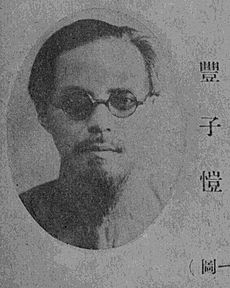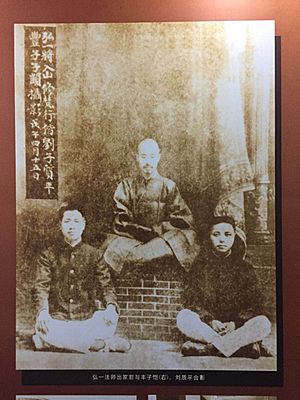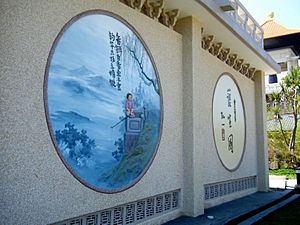Feng Zikai facts for kids
Feng Zikai (simplified Chinese: 丰子恺; traditional Chinese: 豐子愷; pinyin: Fēng Zǐkǎi; November 9, 1898 – September 15, 1975) was a very important Chinese artist and writer. He was a pioneer in a type of Chinese cartoon called manhua. He also wrote many essays and followed Buddhist teachings.
Feng Zikai lived through a lot of big changes in China, from the end of the First Sino-Japanese War to just before the end of the Cultural Revolution. His art and writing often showed how these big political changes affected the daily lives of ordinary people. He is most famous for his paintings of children and his series of Buddhist-inspired art called Paintings for the Preservation of Life. He was also a talented writer, musician, and translator.
Contents
Feng Zikai's Life Story
Early Life and School Days
Feng Zikai grew up in Shimenwan, Zhejiang Province. He was the only son and the youngest of eight children in a well-off family. His family owned a dye shop, which did well because their town was on important trade routes.
Even though his family had a business, Feng Zikai's father spent his time studying for special government exams. Feng Zikai wasn't interested in these traditional studies. Instead, he loved art from a young age. He would even take dyes from his family's shop to color in illustrations from his father's books!
After his father passed away in 1906, Feng Zikai found a book of figures and started tracing and drawing. He became known as the "Little Artist" in his town.
In 1914, Feng Zikai went to the Zhejiang First Normal School (now Hangzhou High School) in Hangzhou. This school was very modern for its time and focused on art and moral education. Many famous artists and writers of the 20th century studied there. Feng Zikai's mother wanted him to become a teacher, hoping he would follow in his father's footsteps.
Learning from a Master
In his third year, a teacher named Li Shutong taught Feng Zikai music and art. Li Shutong later became a famous Buddhist monk known as Hong Yi. He had studied Western painting in Japan.
Li Shutong taught Feng Zikai to sketch from real life, not just trace. He also taught him that a good artist needs both great skill and good character. This idea deeply influenced Feng Zikai's art style. Unlike his parents, Li Shutong encouraged Feng Zikai to follow his passion for art. He also had a big impact on Feng Zikai's spiritual journey later in life.
Starting His Art Career
After finishing school in 1919, Feng Zikai felt he needed more art training. He was also newly married and had family responsibilities. He took a job as an art teacher in Shanghai. However, he felt he wasn't a "modern artist" because he hadn't studied abroad.
So, in 1921, he saved up money and went to Tokyo, Japan. Japan was a popular place for Chinese students to get a modern education. Feng Zikai spent his time studying Japanese and European art. He also tried to learn violin and different languages. He especially liked the work of Japanese artist Takehisa Yumeji. After ten months, he ran out of money but returned home with new ideas for his ink paintings.
Back in China, Feng Zikai worked at Chunhui High School. He also joined a group of writers and artists. His unique style of drawings started appearing in popular magazines like Aesthetic Education and New Youth. These drawings became known as manhua, a type of Chinese cartoon.
Art for Everyone
Feng Zikai worked for the Kaiming Book Company, a publisher that wanted to share "new knowledge" with young people. He designed book covers and illustrated many books. He also helped edit The Juvenile Student, a magazine for young adults. Through this magazine, he shared his art and ideas about kindness and humanity with many students.
During the Second Sino-Japanese War, Feng Zikai drew cartoons showing the terrible effects of war. His art was special because he didn't show the Japanese as monsters. Instead, he focused on the sadness and suffering that war brought to ordinary people. He believed in universal kindness, even when he had to flee his home because of the war.
Feng Zikai stayed in touch with his old teacher, Li Shutong (Hong Yi), until Hong Yi's death in 1942. Hong Yi's Buddhist teachings greatly influenced Feng Zikai's spiritual path and his artwork.
Later Career and Challenges
After 1949, China went through more big changes. Feng Zikai continued his work, but it was sometimes difficult. He faced pressure to change his style to fit new government ideas. Even so, his daughter says he secretly kept his old beliefs and continued to paint and write.
He focused a lot on translating books during this time. In 1954, his earlier manhua cartoons became popular again. Even though some people criticized his art, Premier Zhou Enlai praised it. Feng Zikai was given important roles in art groups in Shanghai.
However, as time went on, he felt he couldn't stay silent about some government policies. He believed in the goals but felt the government wasn't always caring for ordinary people. This led to him being forced to retire. He painted much of his famous Paintings for the Preservation of Life series during this later period, even working with a monk from Singapore to publish them outside China.
Death and Lasting Impact
Feng Zikai passed away on September 9, 1975, from lung cancer. His childhood home in Shimenwan is now the Feng Zikai Memorial Center. Visitors can see his old living spaces and many of his belongings.
Even though many of his original artworks were lost in wars, major museums in China have his art. The Zhejiang Provincial Museum has his entire Paintings for the Preservation of Life collection. There is also a research center at Hangzhou Normal University dedicated to studying his work and that of Hong Yi.
His Paintings for the Preservation of Life have even been turned into murals at the Fo Guang Shan Monastery in Taiwan. Since 2013, the Chinese government has used his paintings in posters for its "China Dream" campaign.
The Feng Zikai Chinese Children's Picture Book Award, started in 2009, is named after him. It celebrates great Chinese children's picture books.
Feng Zikai's Ideas on Life and Art
Feng Zikai's ideas were shaped by his teacher Li Shutong (Hong Yi) and scholar Ma Yifu. He combined ideas from Chinese and Western art, Buddhism, and Confucianism to create his own philosophy.
At the heart of his ideas was the concept of the "childlike heart." He believed that only people with a pure, childlike heart could truly see the world clearly and act kindly. This idea connects to ancient Chinese thinkers like Mencius. Feng Zikai felt that children and artists share a special "sympathetic heart" that allows them to understand and feel for others.
He believed that many problems in society came from a lack of kindness or a focus only on political goals. He saw the failures of different governments in China as signs of this deeper issue. Feng Zikai criticized things like poverty and people not being kind to their elders. He encouraged everyone to look to children for wisdom.
One of his most famous paintings is called Two Fathers. It shows two children holding hands next to a man carrying another person in a rickshaw. The painting suggests that adults often face barriers and difficulties that children, with their simple, pure hearts, are free from. He believed children represent a pure form of humanity.
Published Works
Feng Zikai created many paintings, essays, and translations. Some of his well-known works include:
- Writings from Yuanyuan Hall (缘缘堂随笔)
- Paintings for the Preservation for Life (护生画集)
- A Collection of Feng Zikai Manhua (丰子恺漫画集)
- A biography of artist Vincent van Gogh (梵高生活)
- A translation of the famous Japanese novel The Tale of Genji
He also illustrated some of Lu Xun's stories, like The True Story of Ah Q. He gave lectures on Western classical music, especially about Russian composers.
See also
- Hong Yi
- Pan Tianshou
- Lu Xun
Images for kids





